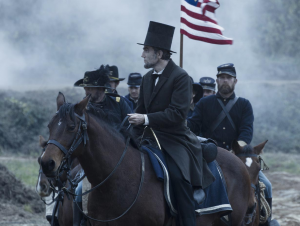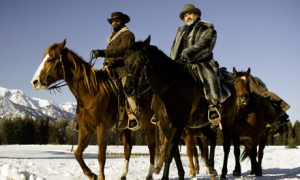Two sides of the same coin: Standing at the intersection of Hollywood and history
22 March 2013 – Jessica Cochran
Pick up a penny. On one side, we observe Lincoln as he was; on the other side, Lincoln as we have chosen to remember him. Public historians face the challenges and rewards of interpreting history for a population obsessed as much with “authenticity” as “legacy.” Films like Lincoln and Django Unchained embody both interests, and should inspire public historians to self-reflection. How can we capitalize on popular interest in historical films? How might they be incorporated into an institution’s interpretation? In what ways should public historians be proactive in planning events, organizing tours, and nurturing dialogue to engage with the issues raised by Lincoln and Django Unchained?

Daniel Day Lewis as Abraham Lincoln surveys the aftermath of battle in Lincoln. Photograph: DreamWorks II Distribution Co., LLC.
History is currently enjoying a moment in the spotlight—mid-19th century history to be specific. The Civil War, slavery, freedom, and emancipation have been topics of national conversation since Steven Spielberg’s Lincoln and Quentin Tarantino’s Django Unchained opened in late 2012. Both films competed for Best Picture at the 2013 Academy Awards on February 24. Lincoln and Django Unchained have received praise and criticism as representations of the past, and conversations normally insular to professional historians have gone mainstream. In cast member and director interviews, movie reviews, blog posts, dinner table and water cooler conversations, many Americans are contemplating what history is, what history means, and who gets to say so. We began to wonder, what role can (or should) public historians play as facilitators and mediators between the public and the past?
Steven Spielberg’s Lincoln portrays the last four months of Abraham Lincoln’s life and his quest to pass the 13th Amendment with gritty, meticulous attention to detail. Quentin Tarantino’s highly stylized version of the antebellum period, Django Unchained, follows the formerly enslaved title character on a bloody mission to find and free his enslaved wife. Many historians and intellectuals have weighed in on Lincoln and Django Unchained in reviews and interviews, noting inaccuracies and the persistence of disturbing tropes. For each movie’s accomplishments, each falls short of a professional historian’s ideal portrayal of history.
But, are Hollywood directors obligated to do the same work as professional historians? Perhaps we all envy their ability to make such influential historical statements. After all, no institution’s special programs related to the sesquicentennial anniversary of the Civil War or the Emancipation Proclamation have made nearly as big an impact as Lincoln and Django Unchained. But, a director’s chief responsibility is to entertain. Does it fall to public historians to bridge the gap between Hollywood and history?
In such a unique moment, we must remember our challenge as public historians to be both engaged with and immersed in the public we serve. In order to best understand how to take advantage of the widespread historical interest generated by Lincoln and Django Unchained, we should consider the nature of that interest. Directors create an emotional experience for their audience, and encourage viewers to relate to someone from the past (fictional or not). In the process, audience members forge an intangible connection to a story in which they played no direct role, or to a person completely unlike themselves. This phenomenon should sound familiar – this is the goal of public history. The similarity between movies and the work of public historians is testament to the inherent potential historical films possess for enriching interpretive frameworks in historical institutions. By engaging with Hollywood versions of history, we might realize that in some cases, half of our work as public historians has already been done for us. Perhaps the other half lies in the difficult task of addressing issues of historicity without invalidating the emotional connections that Lincoln and Django Unchained offer.

Title character Django, played by Jamie Foxx, and Dr. King Schultz, played by Christoph Waltz, form a bounty-hunting team in Django Unchained. Photograph: Rex Features
Taking advantage of public interest in these films could include various types of activities. At the least, interpreters can welcome questions about the movies and embrace the opportunity to improve upon cinematic versions of history. Public historians could pique visitors’ interest in their site by alluding to their links to Lincoln and Django Unchained in marketing materials or tour descriptions, whether they intend to “bust” myths or build upon a movie’s strengths. Staff at President Lincoln’s Cottage at the Soldiers’ Home in Washington, DC wrote several blog entries relating Lincoln to their site and elaborating on important parts of the film such as the Lincoln family’s relationships with their household staff. Special tours, guest lectures, or movie screenings could provide excellent venues to address issues raised by the films, especially in a comparative format. Lincoln and Django Unchained present polarized views on the “hard questions” of 19th century American history. Organizing formal and informal opportunities to discuss the specific differences between the films could lay the groundwork for meaningful dialogue on the historical issues at the core of each film, and even broader questions about history and memory. The team at the public radio program BackStory with the American History Guys opened this line of dialogue with their listeners in their February show, Reel to Real: History at the Movies.
While Django Unchained offers rich interpretive opportunities, Tarantino’s work also poses significant challenges to interpreters. The controversial Django Unchained will probably limit the potential audience (excluding children or families with children) and may alienate some visitors. This, however, is a hazard familiar to public historians who regularly deal with themes of slavery. In order to give visitors a more balanced perspective on Tarantino’s depiction of slavery and the search for freedom, it might be helpful to organize programs which place Django Unchained in conversation with actual slave narratives. How could a roundtable discussion of the autobiography of Frederick Douglass or Harriet Jacobs complicate Hollywood portrayals?
However the field handles these issues, we cannot separate ourselves from popular portrayals of history and the audiences tapping into such representations of slavery, the American Civil War, and any other historical topics that may become objects of the Hollywood spotlight. Now more than ever, perhaps we should be reminded that we represent two sides of the same coin.
~Jessica Cochran and Michael Moore are public history graduate students at North Carolina State University in Raleigh, North Carolina.



